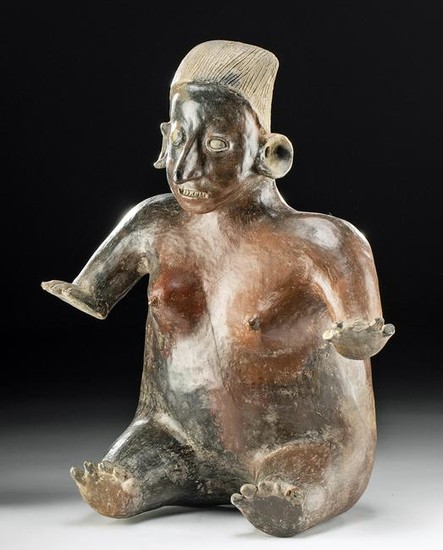Exhibited Jalisco Ameca Redware Nude Female
Pre-Columbian, West Mexico, Jalisco, Ameca type, Protoclassic Period, ca. 100 BCE to 250 CE. A hollow-built redware pottery figure of a sizable form depicting a seated female with highly burnished, red-slipped surfaces. The nude woman sits with a slight forward lean while displaying incised nailbeds on each digit of her extended limbs, and her hemispherical breasts bulge out above her slightly distended abdomen. Her wide-eyed visage bears a distinct aquiline nose and a recessed mouth, cupped ears with perforated ear drums, and a fine striated coiffure which draped between her ears to the top of her neck. Size: 15.375" W x 18.1" H (39.1 cm x 46 cm)
West Mexican shaft tomb figures like this example derive their names from the central architectural feature that we know of from this culture. Jalisco, located on Mexico's southwestern coast, was part of the shaft tomb culture during this time, along with neighbors in nearby Colima and Nayarit. These people would build generally rectangular vertical or near-vertical shafts down from the ground level - usually about 3 to 20 meters deep - through tepetate, the volcanic tuff that makes up the geology of the region, to narrow horizontal tunnels that led to one or more vaulted or rounded burial chambers.
These shafts were almost always dug beneath a dwelling, probably a family home, and seem to have been used as family mausoleums, housing the remains of many related individuals. Figures like this one were placed into the tombs; researchers believe that they were placed around the edges facing inward, as if in conversation with the dead. Grouped with other figures, and alongside clay bowls, and boxes, figures like this one were positioned around the body (or bodies), near the skull.
Provenance: ex-private collection of the late Father Bader, University of St. Thomas, Houston, Texas, USA; exhibited in the University of St. Thomas Art Gallery, acquired prior to 2000
All items legal to buy/sell under U.S. Statute covering cultural patrimony Code 2600, CHAPTER 14, and are guaranteed to be as described or your money back.
A Certificate of Authenticity will accompany all winning bids.
We ship worldwide to most countries and handle all shipping in-house for your convenience.
#154371
Condition Report: Repaired from multiple large pieces, with resurfacing and light overpainting along break lines. Losses to three fingers on one hand and one toe as shown. Abrasions and minor nicks to limbs, body, and head, with fading and areas of fire-darkening to original pigment, and light encrustations. Nice earthen deposits and remains of original pigment throughout.
View it on
Estimate
Time, Location
Auction House
Pre-Columbian, West Mexico, Jalisco, Ameca type, Protoclassic Period, ca. 100 BCE to 250 CE. A hollow-built redware pottery figure of a sizable form depicting a seated female with highly burnished, red-slipped surfaces. The nude woman sits with a slight forward lean while displaying incised nailbeds on each digit of her extended limbs, and her hemispherical breasts bulge out above her slightly distended abdomen. Her wide-eyed visage bears a distinct aquiline nose and a recessed mouth, cupped ears with perforated ear drums, and a fine striated coiffure which draped between her ears to the top of her neck. Size: 15.375" W x 18.1" H (39.1 cm x 46 cm)
West Mexican shaft tomb figures like this example derive their names from the central architectural feature that we know of from this culture. Jalisco, located on Mexico's southwestern coast, was part of the shaft tomb culture during this time, along with neighbors in nearby Colima and Nayarit. These people would build generally rectangular vertical or near-vertical shafts down from the ground level - usually about 3 to 20 meters deep - through tepetate, the volcanic tuff that makes up the geology of the region, to narrow horizontal tunnels that led to one or more vaulted or rounded burial chambers.
These shafts were almost always dug beneath a dwelling, probably a family home, and seem to have been used as family mausoleums, housing the remains of many related individuals. Figures like this one were placed into the tombs; researchers believe that they were placed around the edges facing inward, as if in conversation with the dead. Grouped with other figures, and alongside clay bowls, and boxes, figures like this one were positioned around the body (or bodies), near the skull.
Provenance: ex-private collection of the late Father Bader, University of St. Thomas, Houston, Texas, USA; exhibited in the University of St. Thomas Art Gallery, acquired prior to 2000
All items legal to buy/sell under U.S. Statute covering cultural patrimony Code 2600, CHAPTER 14, and are guaranteed to be as described or your money back.
A Certificate of Authenticity will accompany all winning bids.
We ship worldwide to most countries and handle all shipping in-house for your convenience.
#154371
Condition Report: Repaired from multiple large pieces, with resurfacing and light overpainting along break lines. Losses to three fingers on one hand and one toe as shown. Abrasions and minor nicks to limbs, body, and head, with fading and areas of fire-darkening to original pigment, and light encrustations. Nice earthen deposits and remains of original pigment throughout.



